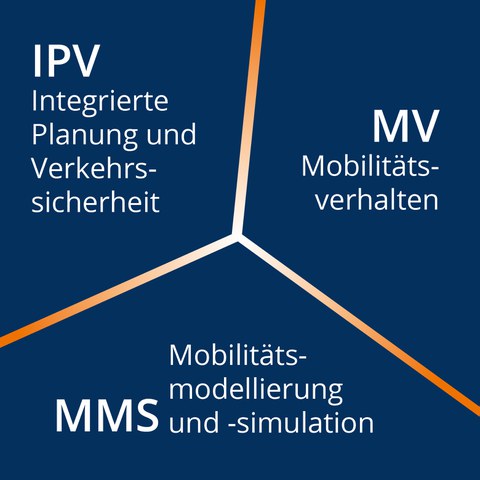Forschungsfelder

Forschungsfelder der Professur
Die drei Forschungsfelder der Professur arbeiten eng zusammen mit vielfältigen Abhängigkeiten und Synergien. Forschung zum Mobilitätsverhalten und zu entsprechenden empirischen Methoden ist verknüpft mit der Mobilitätsmodellierung und -simulation, beides einfließend in die Planung zukunftsfähiger Mobilitätssysteme einschließlich sicherer und attraktiver Straßenräume.
| Mehr Informationen zu unseren Forschungsfeldern erhalten Sie hier: |
|
Gegenstand des Forschungsfelds MV ist die Weiterentwicklung von Methoden zur Erhebung und Analyse von Mobilitätsverhalten und die Anwendung dieser zur Untersuchung und Erklärung von Mobilitätsverhalten und zur Erarbeitung von Strategien zur gezielten Beeinflussung von Mobilitätsverhalten. Unsere Arbeiten im Forschungsfeld gliedern sich in die folgenden drei Themenbereiche:
|
|
Gegenstand des Forschungsfelds IPV ist die Entwicklung von Methoden zur Analyse von Mobilitätssystemen und deren Anwendung zur Untersuchung der Verkehrssicherheit und der Nutzung von Straßenräumen sowie zur Erarbeitung von Strategien für sichere und nachhaltige Mobilitätssysteme. Unsere Arbeiten im Forschungsfeld IPV gliedern sich in die folgenden vier Themenbereiche:
|
|
Der Schwerpunkt des Forschungsfeldes MMS ist die Weiterentwicklung von Modellen, insbesondere Simulationsmodellen, mit dem Ziel, mit ihrer Hilfe Lösungswege für gesellschaftlich relevante Fragestellungen zu erkunden. Thematische Schwerpunkte sind:
|
